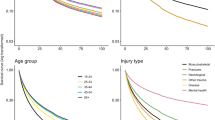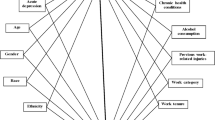Abstract
The aim of the present work was to investigate the influence of different types of injury on the risk for disability retirement among economically active people in Denmark. Material and methods: In this prospective study, all people in the Danish labour force aged 21–54 years 1 January 1997 (N = 2 211 057) were followed for disability retirement during 1997–2001. Age and gender standardised incidence ratios (SIR) were calculated to compare retirement rates among those who received treatment for an injury during 1996 (N = 252 468, including both work-related and non-work related types) with the rates in the total labour force. Life-table methodology was used to calculate years of lost economically active life (YLEAL) by injury type. Results: Among the injured people we observed a total number of 5580 cases of subsequent disability retirement and 45% of these could be statistically attributed to the injury. The SIR for disability retirement by injury type ranged from 1.38 to 7.00. The least severe types, superficial injuries and dislocations, sprains, and strains, were most prevalent and generated the highest numbers of YLEALs. Conclusion: The high frequency of injuries and their influence on retirement rates suggest that injury prevention is a highly relevant approach to reduce future costs from disability retirement. YLEAL calculations can be used to set priorities.

Similar content being viewed by others
References
Razzak JA, Sasser SM, Kellermann AL. Injury prevention and other international public health initiatives. Emerg Med Clin North Am 2005;23:85–98.
Astrand NE, Isacsson SO, Olhagen GO. Prediction of early retirement on the basis of a health examination. An 11-year follow-up of 264 male employees in a Swedish pulp and paper company. Scand J Work Environ Health 1988;14(2):110–7.
Krause N, Lynch J, Kaplan GA, Cohen RD, Goldberg DE, Salonen JT. Predictors of disability retirement. Scand J Work Environ Health 1997;23(6):403–13.
Eriksen W, Natvig B, Rutle O, Bruusgaard D. Smoking as a predictor of long-term work disability in physically active and inactive people. Occup Med (Lond) 1998;48(5):315–20.
Krokstad S, Johnsen R, Westin S. Social determinants of disability pension: a 10-year follow-up of 62,000 people in a Norwegian county population. Int J Epidemiol 2002;31(6):1183–91.
Karpansalo M, Manninen P, Lakka TA, Kauhanen J, Rauramaa R, Salonen JT. Physical workload and risk of early retirement: prospective population-based study among middle-aged men. J Occup Environ Med 2002;44(10):930–9.
Hagen KB, Tambs K, Bjerkedal T. A prospective cohort study of risk factors for disability retirement because of back pain in the general working population. Spine 2002;27(16):1790–6.
Lund T, Iversen L, Poulsen KB. Work environment factors, health, lifestyle and marital status as predictors of job change and early retirement in physically heavy occupations. Am J Ind Med 2001;40(2):161–9.
Hayward MD, Grady WR. Work and retirement among a cohort of older men in the United States, 1966–1983. Demography 1990;27(3):337–56.
Mansson NO, Merlo J. The relation between self-rated health, socioeconomic status, body mass index and disability pension among middle-aged men. Eur J Epidemiol 2001;17(1):65–9.
Brun C, Boggild H, Eshoj P. Socioeconomic risk indicators for disability pension within the Danish workforce. A registry-based cohort study of the period 1994–1998. Ugeskr Laeger 2003;165(35):3315–9. Danish.
Rothenbacher D, Arndt V, Fraisse E, Zschenderlein B, Fliedner TM, Brenner H. Early retirement due to permanent disability in relation to smoking in workers of the construction industry. J Occup Environ Med 1998;40(1):63–8.
Mansson NO, Rastam L. Self-rated health as a predictor of disability pension and death–a prospective study of middle-aged men. Scand J Public Health 2001;29(2):151–8.
Karpansalo M, Lakka TA, Manninen P, Kauhanen J, Rauramaa R, Salonen JT. Cardiorespiratory fitness and risk of disability pension: a prospective population based study in Finnish men. Occup Environ Med 2003;60(10):765–9.
Åstrand NE, Isacsson SO, Olhagen GO. Prediction of early retirement on the basis of a health examination. An 11-year follow-up of 264 male employees in a Swedish pulp and paper company. Scand J Work Environ Health 1988;14:110–7.
Hagen KB, Tambs K, Bjerkedal T. A prospective cohort study of risk factors for disability retirement because of back pain in the general working population. Spine 2002;27:1790–6.
Eriksen W, Natvig B, Rutle O, Bruusgaard D. Smoking as a predictor of long-term work disability in physically active and inactive people. Occup Med 1998;48:315–20.
Krause N, Dasinger LK, Neuhauser F. Modified work and return to work: a review of the literature. J Occup Rehabil 1998;8:113–139.
Williams RM, Westmorland M. Perspectives on workplace disability management: a review of the literature. Work 2002;19(1):87–93.
Baldwin ML. Reducing the costs of work-related musculoskeletal disorders: targeting strategies to chronic disability cases. J Electromyogr Kinesiol 2004;14(1):33–41.
Soll-Johanning H, Hannerz H, Tüchsen F. Referral bias in hospital register studies of geographical and industrial differences in health. Dan Med Bull 2004;51:207–10.
Eurostat. European statistics on accidents at work (ESAW)–Methodology–2001 edition, Luxembourg: Office for Official Publications of the European Communities; 2001.
Hernberg S. Introduction to occupational epidemiology. Chelsea, Michigan: Lewis Publishers; 1992.
Zohar D, Luria G. The use of supervisory practices as leverage to improve safety behavior: a cross-level intervention model. J Safety Res 2003;34:567–77.
Lund J, Aarø LE. Accident prevention of a model placing emphasis on human, structural and cultural factors. Safety Science 2004;42:271–324.
Laitinen H, Marjamaki M, Paivarinta K. The validity of the TR safety observation method on building construction. Accid Anal Prev 1999;31:463–72.
Baarts C, Mikkelsen KL, Hannerz H, Tuchsen F. Use of a national hospitalization register to identify industrial sectors carrying high risk of severe injuries: A three-year cohort study of more than 900,000 Danish men. Am J Ind Med 2000;38:619–27.
Spangenberg S, Mikkelsen KL, Kines P, Dyreborg J, Baarts C. The construction of the Øresund Link between Denmark and Sweden: the effect of a multifaceted safety campaign. Safety Sci 2002;40:457–65.
Spangenberg S, Baarts C, Dyreborg J, Jensen L, Kines P, Mikkelsen KL. Factors contributing to the differences in work related injury rates between Danish and Swedish construction workers. Safety Sci 2003;41:517–30.
Labriola M, Lund T, Burr H. Prospective study of physical and psychosocial risk factors for sickness absence. Occup Med (Lond) 2006;56(7):469–74.
Eurostat. Accidents at work and work-related health problems, Data 1994–2000. Luxembourg: Office for Official Publications of the European Communities; 2002.
Danish Ministry of Employment. Rent arbejdsmiljø år 2005. Arbejdsministeriets handlingsprogram. København: Arbejdsministeriet; 1996.
Danish Working Environment Authority. Fremtidens arbejdsmiljø. København: Arbejdstilsynet; 2005.
Marisol C-B, Deborah IN, Marilyn F, Timothy D, James L. The global burden due to occupational injury. Am J Ind Med 2005;48:470–481.
O’Donnell ML, Creamer M, Pattison P, Atkin C. Psychiatric morbidity following injury. Am J Psychiatry 2004;161:507–14.
Author information
Authors and Affiliations
Corresponding author
Rights and permissions
About this article
Cite this article
Hannerz, H., Spangenberg, S., Tüchsen, F. et al. Prospective Analysis of Disability Retirement as a Consequence of Injuries in a Labour Force Population. J Occup Rehabil 17, 11–18 (2007). https://doi.org/10.1007/s10926-007-9067-2
Published:
Issue Date:
DOI: https://doi.org/10.1007/s10926-007-9067-2




